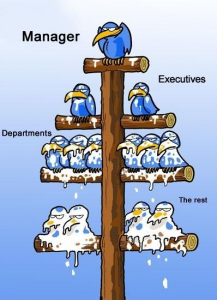Ken Blanchard coined the term The Seagull Manager in his 1985 book Leadership and the One Minute Manager. Blanchard described Seagull Managers who fly in, make a lot of noise, dump on everyone, then fly out. Do agile methods help or hinder this problem?
This perception of Management continues. A similar story is depicted in the image below (source unknown) that has gone viral on the internet.
Search for “the best flow chart ever” and read a selection of the comments. Clearly not much has changed in the past 20 years.
It seems that, despite widespread use of new development methodologies such as Agile, the chasm between development teams and senior management remains, perhaps it is even getting wider.
I firmly believe that, when both sides of the divide come together to bridge that gap, we can only help business efficiency and ultimately product quality.

Hi Pete,
Interesting thoughts. There is certainly plenty of evidence to suggest that senior management is rather, how shall we say, distance from Agile teams as we typically know them.
But what does “typical” in this context mean? In Switzerland, 85% of companies that use agile techniques, use scrum. Scrum is very simple and elegant yet does not address the needs of senior management and executives.
These individuals therefore, find themselves in such a position that they are damned if they do and damned if they don’t. Let’s be specific: On the one hand they need to exercise governance to show that they are able to demonstrate that they are in control of major investments and projects, often multi-million-dollar.
Whilst on the other hand however, the world is changing faster than ever. The scope of projects will change constantly. It is almost impossible to fix scope for one, let alone two years or more. Change will happen. It is inevitable.
So how do organisations embrace change yet also demonstrate control?
This is where agile project management methods such as DSDM (dynamic systems delivery method) fit well. DSDM satisfies the need of executive and project managers whilst allowing the project delivery to be agile in a way that the teams have come to love with Scrum.
It is therefore possible to be agile and demonstrate that you are in control of the project.
As such, this divide you speak about can be closed even today, right now, which can only be beneficial product development, innovation and the business as a whole.
HNew methodologies are fine and I am sure DSDM can add value on the ground. Developers and middle managers are normally repsonsive to learning new ways of working if these techniques will reduce pain.
I am somewhat concerned about “training” the seagulls at the top of the pile. Such birds are often not so receptive to learning new methods unless their learning involves very litlle pain (no more than a few feathers). Your thoughts?
Hi Pete,
The seagulls operate at a different level in many respects to developers and middle managers. They don’t need to understand the ins and outs of methods. However, they do need to understand their role within the context of the work being done.
For example, DSDM will ask these two very basic questions:
1. The business sponsor demonstrates clear ownership of the project.
2. The business sponsor understands and accepts the DSDM philosophy.
The philosophy contains a number of points and here are two relevant to this subject:
“…is that any project must be aligned to clearly defined strategic goals and focus on early delivery of real benefits to business.
The stakeholders must be prepared to deliver a fit for purpose solution. They must also be prepared to accept the change is inevitable as they understand more about the solution being developed….”
In other words, if senior management want upfront detailed plans and specifications then such an approach as DSDM will be a major challenge.
So as long as the seagulls understand their role and the philosophy of agile project management then the project will have a greater chance of success.